STAT6000: Analyzing Public Health Research Statistics Assignment 2
VerifiedAdded on 2023/05/29
|13
|2484
|200
Report
AI Summary
This report analyzes two research articles on public health, focusing on the application and interpretation of statistical methods. The first article investigates alcohol and drug use among school leavers, examining the patterns, influences, and impacts of substance consumption during celebratory events. It explores hypothesis testing, independent and dependent variables, sampling techniques, and the use of odds ratios to determine relationships between variables such as safety strategies and unprotected sex. The second article investigates the prevalence of self-reported diabetes mellitus in a Chinese population, evaluating factors associated with diabetes over several years. The analysis covers demographic characteristics, statistical inference, prevalence rates, and limitations of the study. The report critically assesses the statistical methods used, including the interpretation of inferential data and the identification of potential biases and limitations within each study. Both articles provide valuable insights into the application of statistics in public health research.
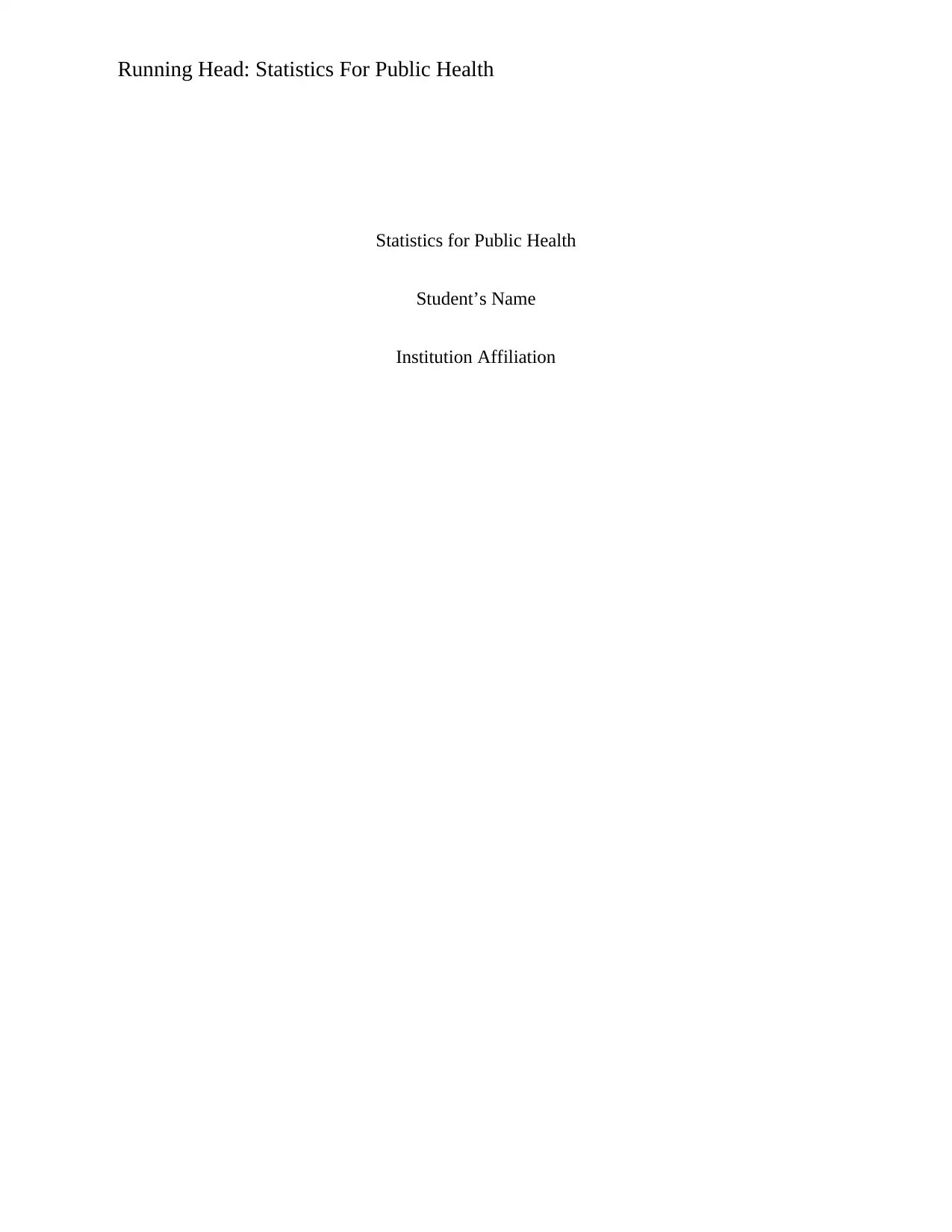
Running Head: Statistics For Public Health
Statistics for Public Health
Student’s Name
Institution Affiliation
Statistics for Public Health
Student’s Name
Institution Affiliation
Paraphrase This Document
Need a fresh take? Get an instant paraphrase of this document with our AI Paraphraser
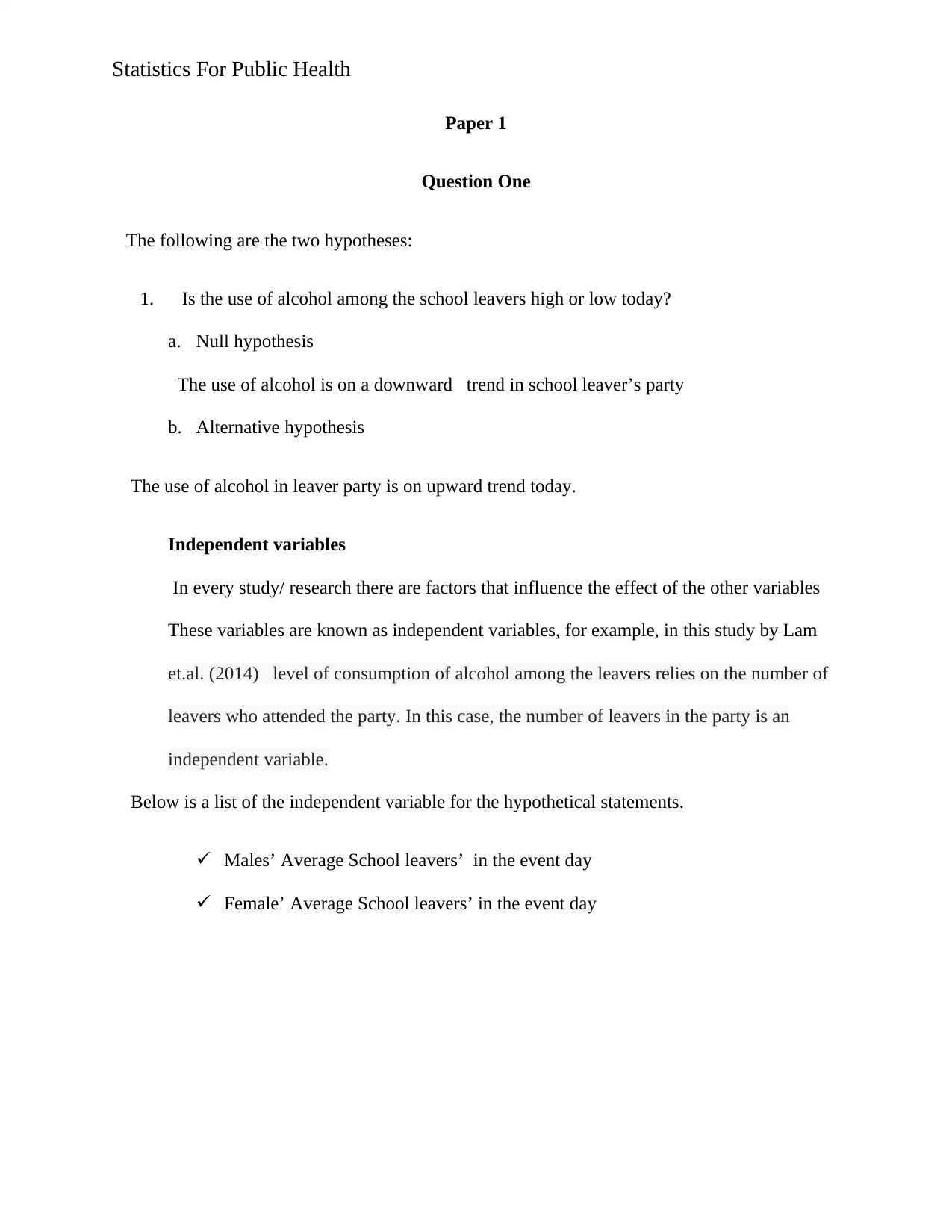
Statistics For Public Health
Paper 1
Question One
The following are the two hypotheses:
1. Is the use of alcohol among the school leavers high or low today?
a. Null hypothesis
The use of alcohol is on a downward trend in school leaver’s party
b. Alternative hypothesis
The use of alcohol in leaver party is on upward trend today.
Independent variables
In every study/ research there are factors that influence the effect of the other variables
These variables are known as independent variables, for example, in this study by Lam
et.al. (2014) level of consumption of alcohol among the leavers relies on the number of
leavers who attended the party. In this case, the number of leavers in the party is an
independent variable.
Below is a list of the independent variable for the hypothetical statements.
Males’ Average School leavers’ in the event day
Female’ Average School leavers’ in the event day
Paper 1
Question One
The following are the two hypotheses:
1. Is the use of alcohol among the school leavers high or low today?
a. Null hypothesis
The use of alcohol is on a downward trend in school leaver’s party
b. Alternative hypothesis
The use of alcohol in leaver party is on upward trend today.
Independent variables
In every study/ research there are factors that influence the effect of the other variables
These variables are known as independent variables, for example, in this study by Lam
et.al. (2014) level of consumption of alcohol among the leavers relies on the number of
leavers who attended the party. In this case, the number of leavers in the party is an
independent variable.
Below is a list of the independent variable for the hypothetical statements.
Males’ Average School leavers’ in the event day
Female’ Average School leavers’ in the event day

Statistics For Public Health
Dependent Variables
These are factors or variables whose effects are influenced by the independent variables,
(Heeringa, West & Berglund, 2017). for example, the level of alcohol consumption in Australia
among the school leaver in a shed off parties will largely depend on the number of leavers in
these parties. In this case, the level of alcohol consumption is leaver party is the dependent
variable.
These result variables that depend on the estimates of the independent variables. Coming up next
are the variables for the hypothetical statement:
Amount of alcohol consumed for the all event days
Daily average consumption of alcohol in the event days
2. What is the level of the use of other drugs apart from alcohol among the school leavers,
in their final party?
a. Null hypothesis
The use of drugs such as other drugs like amphetamine, caffeine, and cannabis has been the
same.
b. Alternative hypothesis
The use of drugs such as other drugs like amphetamine, caffeine, and cannabis among the school
leavers as they celebrate their final party has been grown by a great number.
Dependent Variables
These are factors or variables whose effects are influenced by the independent variables,
(Heeringa, West & Berglund, 2017). for example, the level of alcohol consumption in Australia
among the school leaver in a shed off parties will largely depend on the number of leavers in
these parties. In this case, the level of alcohol consumption is leaver party is the dependent
variable.
These result variables that depend on the estimates of the independent variables. Coming up next
are the variables for the hypothetical statement:
Amount of alcohol consumed for the all event days
Daily average consumption of alcohol in the event days
2. What is the level of the use of other drugs apart from alcohol among the school leavers,
in their final party?
a. Null hypothesis
The use of drugs such as other drugs like amphetamine, caffeine, and cannabis has been the
same.
b. Alternative hypothesis
The use of drugs such as other drugs like amphetamine, caffeine, and cannabis among the school
leavers as they celebrate their final party has been grown by a great number.
⊘ This is a preview!⊘
Do you want full access?
Subscribe today to unlock all pages.

Trusted by 1+ million students worldwide
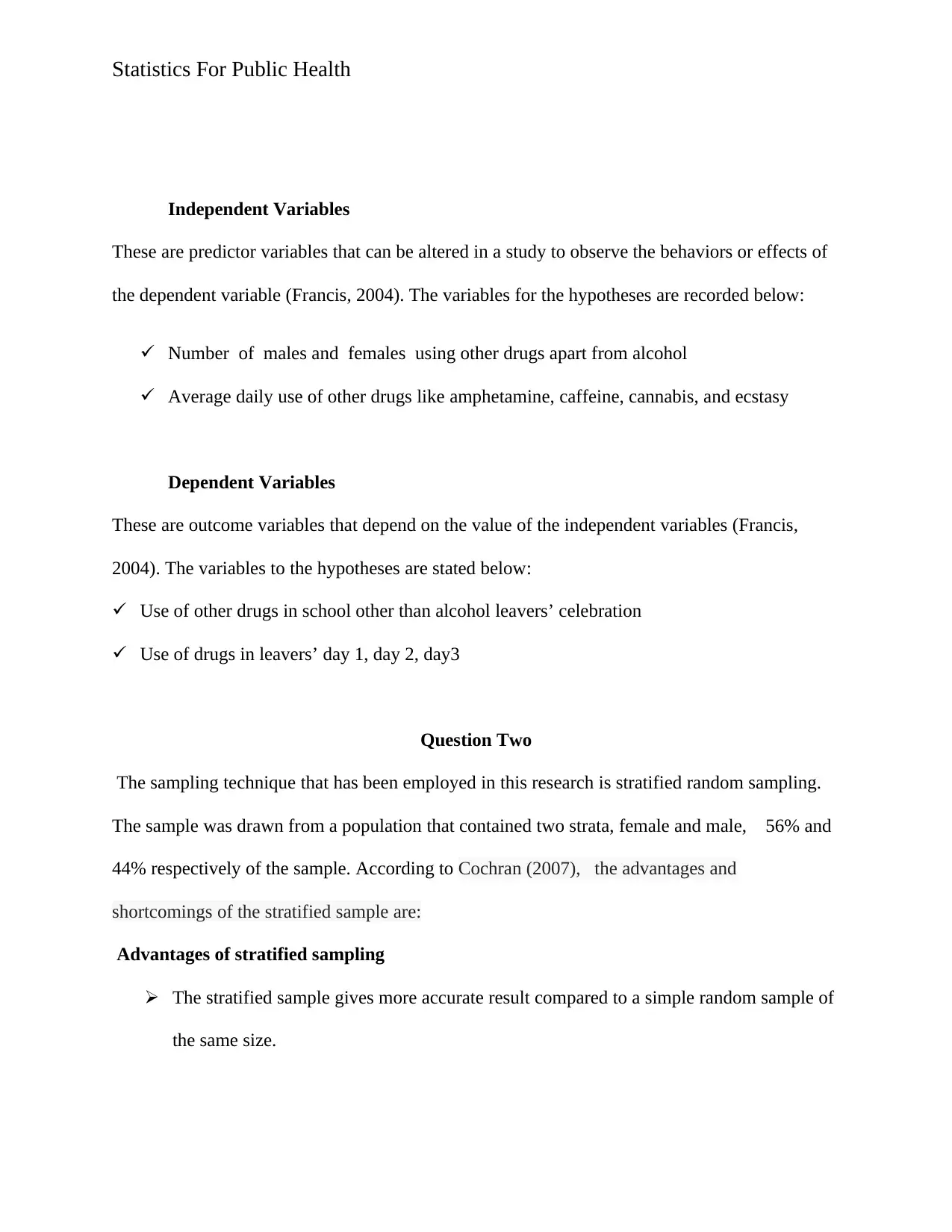
Statistics For Public Health
Independent Variables
These are predictor variables that can be altered in a study to observe the behaviors or effects of
the dependent variable (Francis, 2004). The variables for the hypotheses are recorded below:
Number of males and females using other drugs apart from alcohol
Average daily use of other drugs like amphetamine, caffeine, cannabis, and ecstasy
Dependent Variables
These are outcome variables that depend on the value of the independent variables (Francis,
2004). The variables to the hypotheses are stated below:
Use of other drugs in school other than alcohol leavers’ celebration
Use of drugs in leavers’ day 1, day 2, day3
Question Two
The sampling technique that has been employed in this research is stratified random sampling.
The sample was drawn from a population that contained two strata, female and male, 56% and
44% respectively of the sample. According to Cochran (2007), the advantages and
shortcomings of the stratified sample are:
Advantages of stratified sampling
The stratified sample gives more accurate result compared to a simple random sample of
the same size.
Independent Variables
These are predictor variables that can be altered in a study to observe the behaviors or effects of
the dependent variable (Francis, 2004). The variables for the hypotheses are recorded below:
Number of males and females using other drugs apart from alcohol
Average daily use of other drugs like amphetamine, caffeine, cannabis, and ecstasy
Dependent Variables
These are outcome variables that depend on the value of the independent variables (Francis,
2004). The variables to the hypotheses are stated below:
Use of other drugs in school other than alcohol leavers’ celebration
Use of drugs in leavers’ day 1, day 2, day3
Question Two
The sampling technique that has been employed in this research is stratified random sampling.
The sample was drawn from a population that contained two strata, female and male, 56% and
44% respectively of the sample. According to Cochran (2007), the advantages and
shortcomings of the stratified sample are:
Advantages of stratified sampling
The stratified sample gives more accurate result compared to a simple random sample of
the same size.
Paraphrase This Document
Need a fresh take? Get an instant paraphrase of this document with our AI Paraphraser
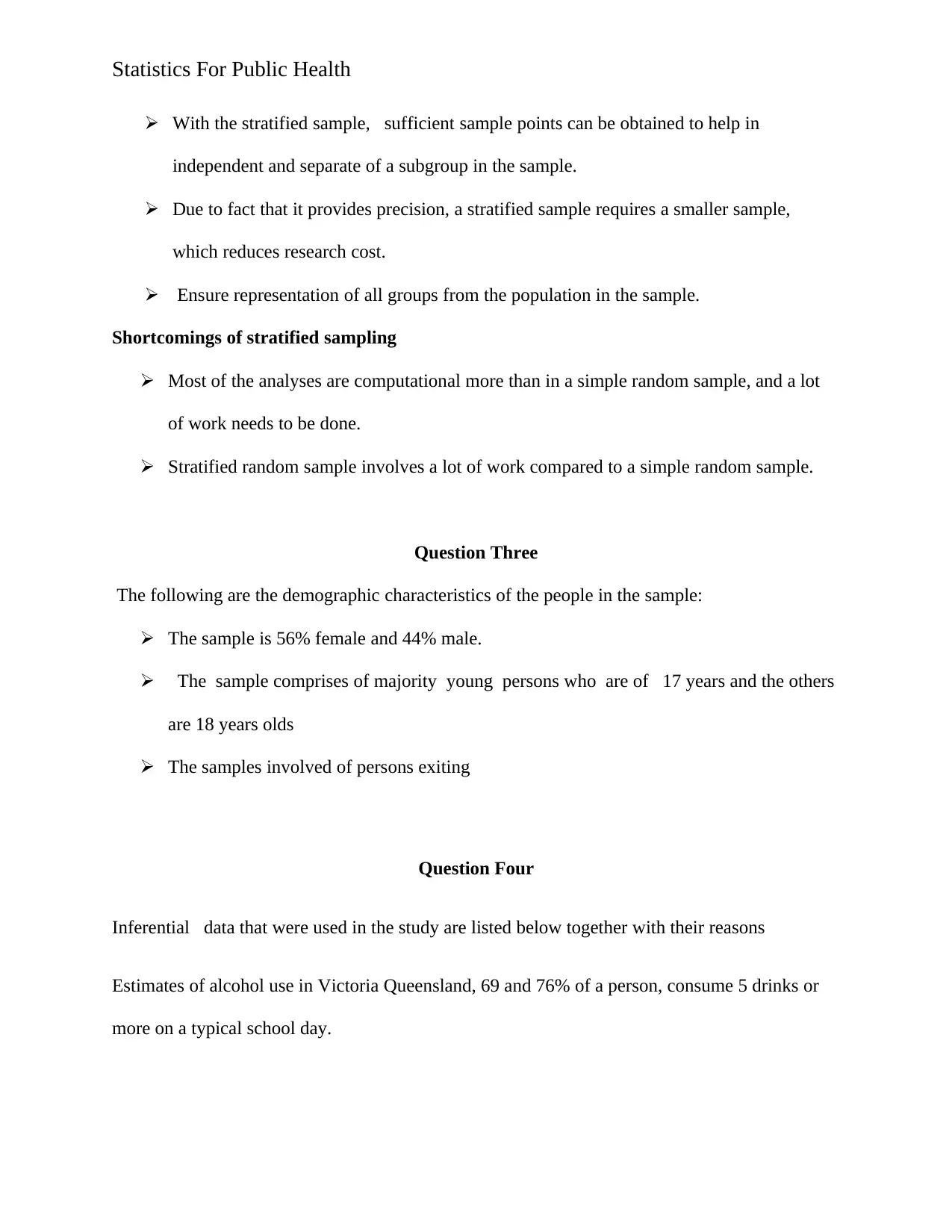
Statistics For Public Health
With the stratified sample, sufficient sample points can be obtained to help in
independent and separate of a subgroup in the sample.
Due to fact that it provides precision, a stratified sample requires a smaller sample,
which reduces research cost.
Ensure representation of all groups from the population in the sample.
Shortcomings of stratified sampling
Most of the analyses are computational more than in a simple random sample, and a lot
of work needs to be done.
Stratified random sample involves a lot of work compared to a simple random sample.
Question Three
The following are the demographic characteristics of the people in the sample:
The sample is 56% female and 44% male.
The sample comprises of majority young persons who are of 17 years and the others
are 18 years olds
The samples involved of persons exiting
Question Four
Inferential data that were used in the study are listed below together with their reasons
Estimates of alcohol use in Victoria Queensland, 69 and 76% of a person, consume 5 drinks or
more on a typical school day.
With the stratified sample, sufficient sample points can be obtained to help in
independent and separate of a subgroup in the sample.
Due to fact that it provides precision, a stratified sample requires a smaller sample,
which reduces research cost.
Ensure representation of all groups from the population in the sample.
Shortcomings of stratified sampling
Most of the analyses are computational more than in a simple random sample, and a lot
of work needs to be done.
Stratified random sample involves a lot of work compared to a simple random sample.
Question Three
The following are the demographic characteristics of the people in the sample:
The sample is 56% female and 44% male.
The sample comprises of majority young persons who are of 17 years and the others
are 18 years olds
The samples involved of persons exiting
Question Four
Inferential data that were used in the study are listed below together with their reasons
Estimates of alcohol use in Victoria Queensland, 69 and 76% of a person, consume 5 drinks or
more on a typical school day.
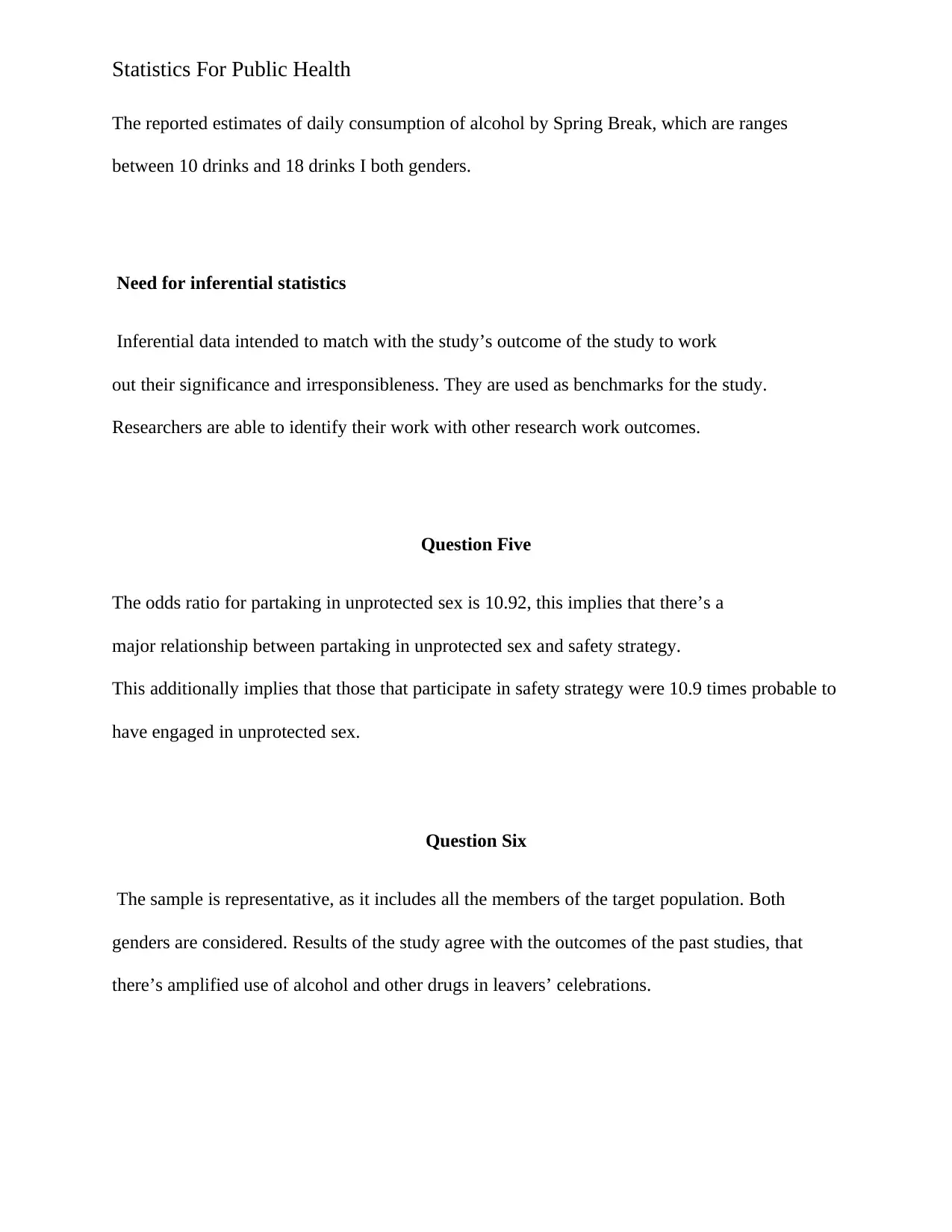
Statistics For Public Health
The reported estimates of daily consumption of alcohol by Spring Break, which are ranges
between 10 drinks and 18 drinks I both genders.
Need for inferential statistics
Inferential data intended to match with the study’s outcome of the study to work
out their significance and irresponsibleness. They are used as benchmarks for the study.
Researchers are able to identify their work with other research work outcomes.
Question Five
The odds ratio for partaking in unprotected sex is 10.92, this implies that there’s a
major relationship between partaking in unprotected sex and safety strategy.
This additionally implies that those that participate in safety strategy were 10.9 times probable to
have engaged in unprotected sex.
Question Six
The sample is representative, as it includes all the members of the target population. Both
genders are considered. Results of the study agree with the outcomes of the past studies, that
there’s amplified use of alcohol and other drugs in leavers’ celebrations.
The reported estimates of daily consumption of alcohol by Spring Break, which are ranges
between 10 drinks and 18 drinks I both genders.
Need for inferential statistics
Inferential data intended to match with the study’s outcome of the study to work
out their significance and irresponsibleness. They are used as benchmarks for the study.
Researchers are able to identify their work with other research work outcomes.
Question Five
The odds ratio for partaking in unprotected sex is 10.92, this implies that there’s a
major relationship between partaking in unprotected sex and safety strategy.
This additionally implies that those that participate in safety strategy were 10.9 times probable to
have engaged in unprotected sex.
Question Six
The sample is representative, as it includes all the members of the target population. Both
genders are considered. Results of the study agree with the outcomes of the past studies, that
there’s amplified use of alcohol and other drugs in leavers’ celebrations.
⊘ This is a preview!⊘
Do you want full access?
Subscribe today to unlock all pages.

Trusted by 1+ million students worldwide
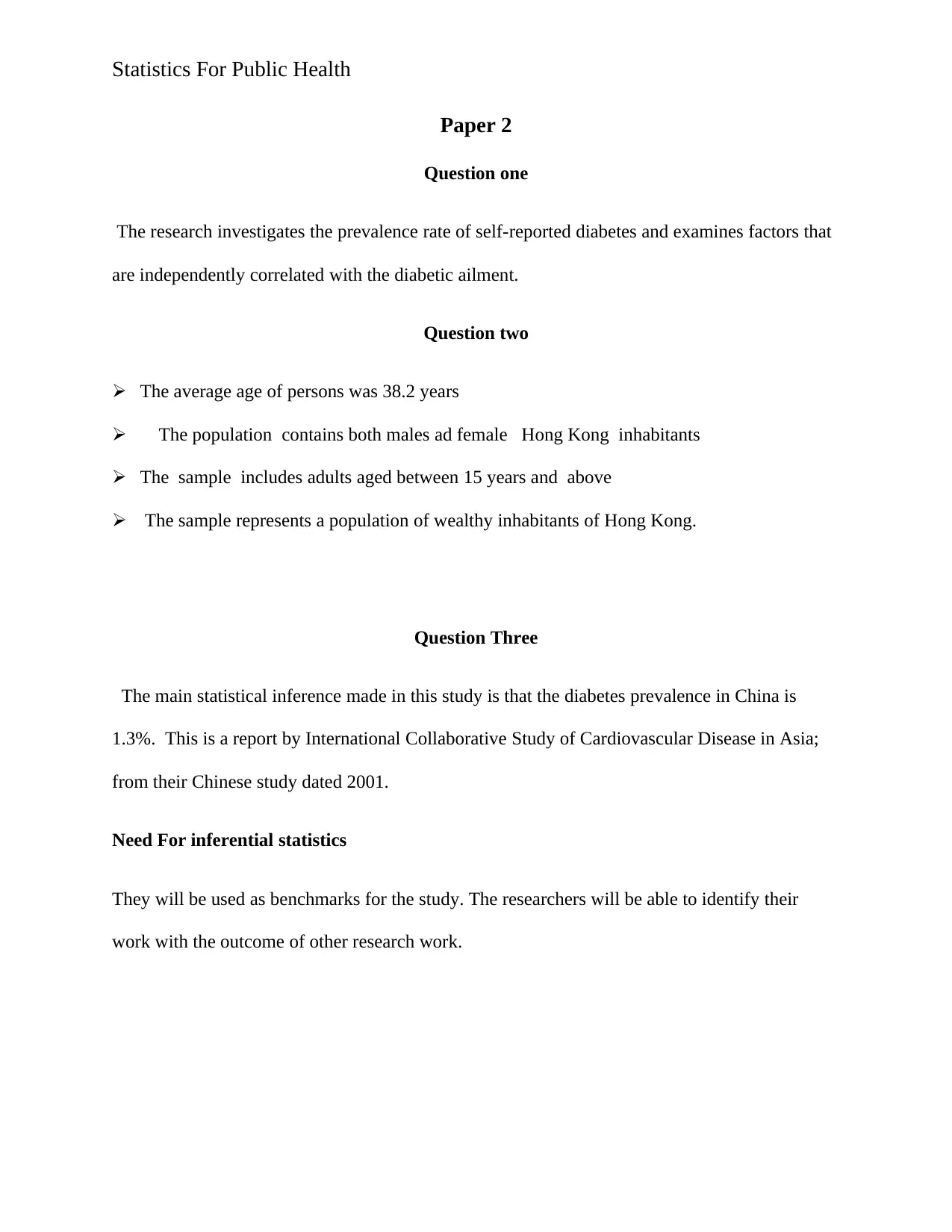
Statistics For Public Health
Paper 2
Question one
The research investigates the prevalence rate of self-reported diabetes and examines factors that
are independently correlated with the diabetic ailment.
Question two
The average age of persons was 38.2 years
The population contains both males ad female Hong Kong inhabitants
The sample includes adults aged between 15 years and above
The sample represents a population of wealthy inhabitants of Hong Kong.
Question Three
The main statistical inference made in this study is that the diabetes prevalence in China is
1.3%. This is a report by International Collaborative Study of Cardiovascular Disease in Asia;
from their Chinese study dated 2001.
Need For inferential statistics
They will be used as benchmarks for the study. The researchers will be able to identify their
work with the outcome of other research work.
Paper 2
Question one
The research investigates the prevalence rate of self-reported diabetes and examines factors that
are independently correlated with the diabetic ailment.
Question two
The average age of persons was 38.2 years
The population contains both males ad female Hong Kong inhabitants
The sample includes adults aged between 15 years and above
The sample represents a population of wealthy inhabitants of Hong Kong.
Question Three
The main statistical inference made in this study is that the diabetes prevalence in China is
1.3%. This is a report by International Collaborative Study of Cardiovascular Disease in Asia;
from their Chinese study dated 2001.
Need For inferential statistics
They will be used as benchmarks for the study. The researchers will be able to identify their
work with the outcome of other research work.
Paraphrase This Document
Need a fresh take? Get an instant paraphrase of this document with our AI Paraphraser
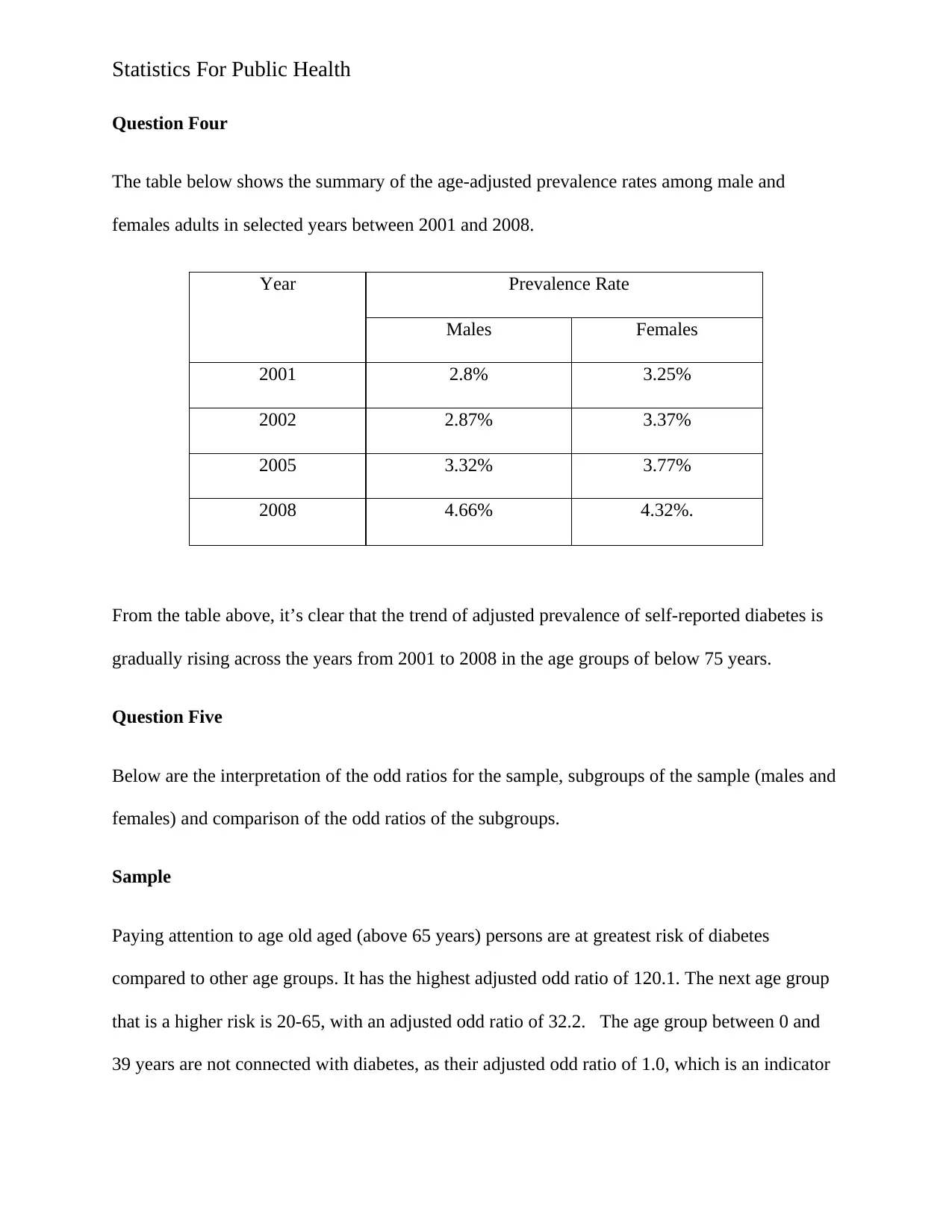
Statistics For Public Health
Question Four
The table below shows the summary of the age-adjusted prevalence rates among male and
females adults in selected years between 2001 and 2008.
Year Prevalence Rate
Males Females
2001 2.8% 3.25%
2002 2.87% 3.37%
2005 3.32% 3.77%
2008 4.66% 4.32%.
From the table above, it’s clear that the trend of adjusted prevalence of self-reported diabetes is
gradually rising across the years from 2001 to 2008 in the age groups of below 75 years.
Question Five
Below are the interpretation of the odd ratios for the sample, subgroups of the sample (males and
females) and comparison of the odd ratios of the subgroups.
Sample
Paying attention to age old aged (above 65 years) persons are at greatest risk of diabetes
compared to other age groups. It has the highest adjusted odd ratio of 120.1. The next age group
that is a higher risk is 20-65, with an adjusted odd ratio of 32.2. The age group between 0 and
39 years are not connected with diabetes, as their adjusted odd ratio of 1.0, which is an indicator
Question Four
The table below shows the summary of the age-adjusted prevalence rates among male and
females adults in selected years between 2001 and 2008.
Year Prevalence Rate
Males Females
2001 2.8% 3.25%
2002 2.87% 3.37%
2005 3.32% 3.77%
2008 4.66% 4.32%.
From the table above, it’s clear that the trend of adjusted prevalence of self-reported diabetes is
gradually rising across the years from 2001 to 2008 in the age groups of below 75 years.
Question Five
Below are the interpretation of the odd ratios for the sample, subgroups of the sample (males and
females) and comparison of the odd ratios of the subgroups.
Sample
Paying attention to age old aged (above 65 years) persons are at greatest risk of diabetes
compared to other age groups. It has the highest adjusted odd ratio of 120.1. The next age group
that is a higher risk is 20-65, with an adjusted odd ratio of 32.2. The age group between 0 and
39 years are not connected with diabetes, as their adjusted odd ratio of 1.0, which is an indicator
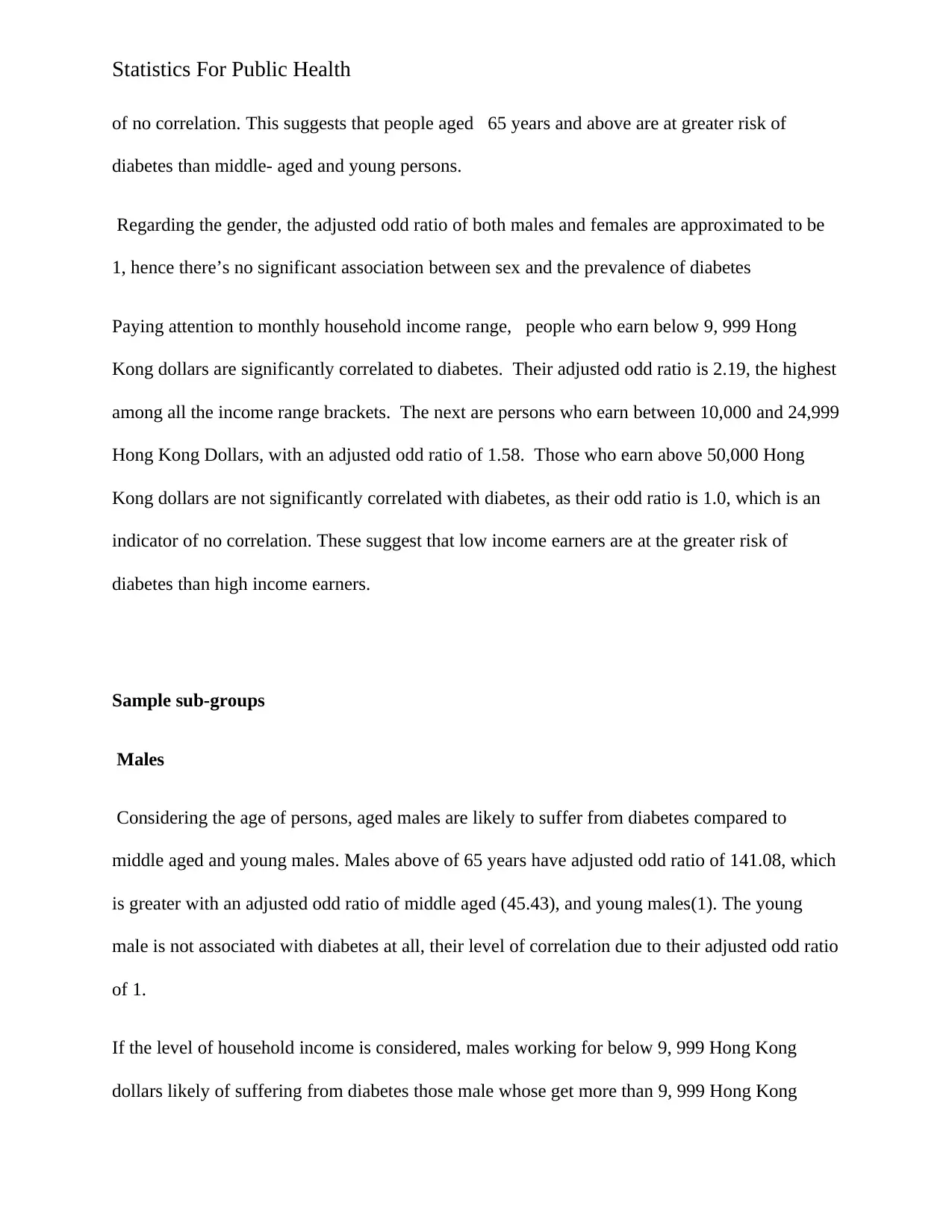
Statistics For Public Health
of no correlation. This suggests that people aged 65 years and above are at greater risk of
diabetes than middle- aged and young persons.
Regarding the gender, the adjusted odd ratio of both males and females are approximated to be
1, hence there’s no significant association between sex and the prevalence of diabetes
Paying attention to monthly household income range, people who earn below 9, 999 Hong
Kong dollars are significantly correlated to diabetes. Their adjusted odd ratio is 2.19, the highest
among all the income range brackets. The next are persons who earn between 10,000 and 24,999
Hong Kong Dollars, with an adjusted odd ratio of 1.58. Those who earn above 50,000 Hong
Kong dollars are not significantly correlated with diabetes, as their odd ratio is 1.0, which is an
indicator of no correlation. These suggest that low income earners are at the greater risk of
diabetes than high income earners.
Sample sub-groups
Males
Considering the age of persons, aged males are likely to suffer from diabetes compared to
middle aged and young males. Males above of 65 years have adjusted odd ratio of 141.08, which
is greater with an adjusted odd ratio of middle aged (45.43), and young males(1). The young
male is not associated with diabetes at all, their level of correlation due to their adjusted odd ratio
of 1.
If the level of household income is considered, males working for below 9, 999 Hong Kong
dollars likely of suffering from diabetes those male whose get more than 9, 999 Hong Kong
of no correlation. This suggests that people aged 65 years and above are at greater risk of
diabetes than middle- aged and young persons.
Regarding the gender, the adjusted odd ratio of both males and females are approximated to be
1, hence there’s no significant association between sex and the prevalence of diabetes
Paying attention to monthly household income range, people who earn below 9, 999 Hong
Kong dollars are significantly correlated to diabetes. Their adjusted odd ratio is 2.19, the highest
among all the income range brackets. The next are persons who earn between 10,000 and 24,999
Hong Kong Dollars, with an adjusted odd ratio of 1.58. Those who earn above 50,000 Hong
Kong dollars are not significantly correlated with diabetes, as their odd ratio is 1.0, which is an
indicator of no correlation. These suggest that low income earners are at the greater risk of
diabetes than high income earners.
Sample sub-groups
Males
Considering the age of persons, aged males are likely to suffer from diabetes compared to
middle aged and young males. Males above of 65 years have adjusted odd ratio of 141.08, which
is greater with an adjusted odd ratio of middle aged (45.43), and young males(1). The young
male is not associated with diabetes at all, their level of correlation due to their adjusted odd ratio
of 1.
If the level of household income is considered, males working for below 9, 999 Hong Kong
dollars likely of suffering from diabetes those male whose get more than 9, 999 Hong Kong
⊘ This is a preview!⊘
Do you want full access?
Subscribe today to unlock all pages.

Trusted by 1+ million students worldwide

Statistics For Public Health
dollars. Their adjusted odd ratio is 2.28, the highest among all the income range brackets. The
males who make above 50,000 Hong Kong dollars have low chances of suffering from diabetes,
this has been revealed by adjusted odd ratio is 1.0, which is an indicator of no correlation.
Females
Considering the age, an elderly female is likely to suffer from diabetes compared to the middle
aged and young females. Females above of 65 years have adjusted the odd ratio of 105.45, which
is greater with an adjusted odd ratio of middle aged(23.49), and young females (1). The young
female is not associated with diabetes at all, their level of correlation due to their adjusted odd
ratio of 1.
If the level of household income is considered, a female working for below 9, 999 Hong Kong
dollars a month is likely of suffering from diabetes that a female whose get more than 9, 999
Hong Kong dollars. Their adjusted odd ratio is 2.28, the highest among all the income range
brackets. The female who make above 50,000 Hong Kong dollars have low chances of
suffering from diabetes, this has been revealed by adjusted odd ratio is 1.0, which is an
indicator of no correlation
Comparison of Males and Females Subgroups
If age were to be put into considerations, aged males are more likely to suffer from diabetes
compared to aged females. The adjusted odd ratio of aged males is higher than that of aged
females. Moreover, young persons aged between 0 and 39 years from both genders are not
correlated with diabetes, their adjusted odd ratio is 1, which is an indicator of no correlation.
dollars. Their adjusted odd ratio is 2.28, the highest among all the income range brackets. The
males who make above 50,000 Hong Kong dollars have low chances of suffering from diabetes,
this has been revealed by adjusted odd ratio is 1.0, which is an indicator of no correlation.
Females
Considering the age, an elderly female is likely to suffer from diabetes compared to the middle
aged and young females. Females above of 65 years have adjusted the odd ratio of 105.45, which
is greater with an adjusted odd ratio of middle aged(23.49), and young females (1). The young
female is not associated with diabetes at all, their level of correlation due to their adjusted odd
ratio of 1.
If the level of household income is considered, a female working for below 9, 999 Hong Kong
dollars a month is likely of suffering from diabetes that a female whose get more than 9, 999
Hong Kong dollars. Their adjusted odd ratio is 2.28, the highest among all the income range
brackets. The female who make above 50,000 Hong Kong dollars have low chances of
suffering from diabetes, this has been revealed by adjusted odd ratio is 1.0, which is an
indicator of no correlation
Comparison of Males and Females Subgroups
If age were to be put into considerations, aged males are more likely to suffer from diabetes
compared to aged females. The adjusted odd ratio of aged males is higher than that of aged
females. Moreover, young persons aged between 0 and 39 years from both genders are not
correlated with diabetes, their adjusted odd ratio is 1, which is an indicator of no correlation.
Paraphrase This Document
Need a fresh take? Get an instant paraphrase of this document with our AI Paraphraser
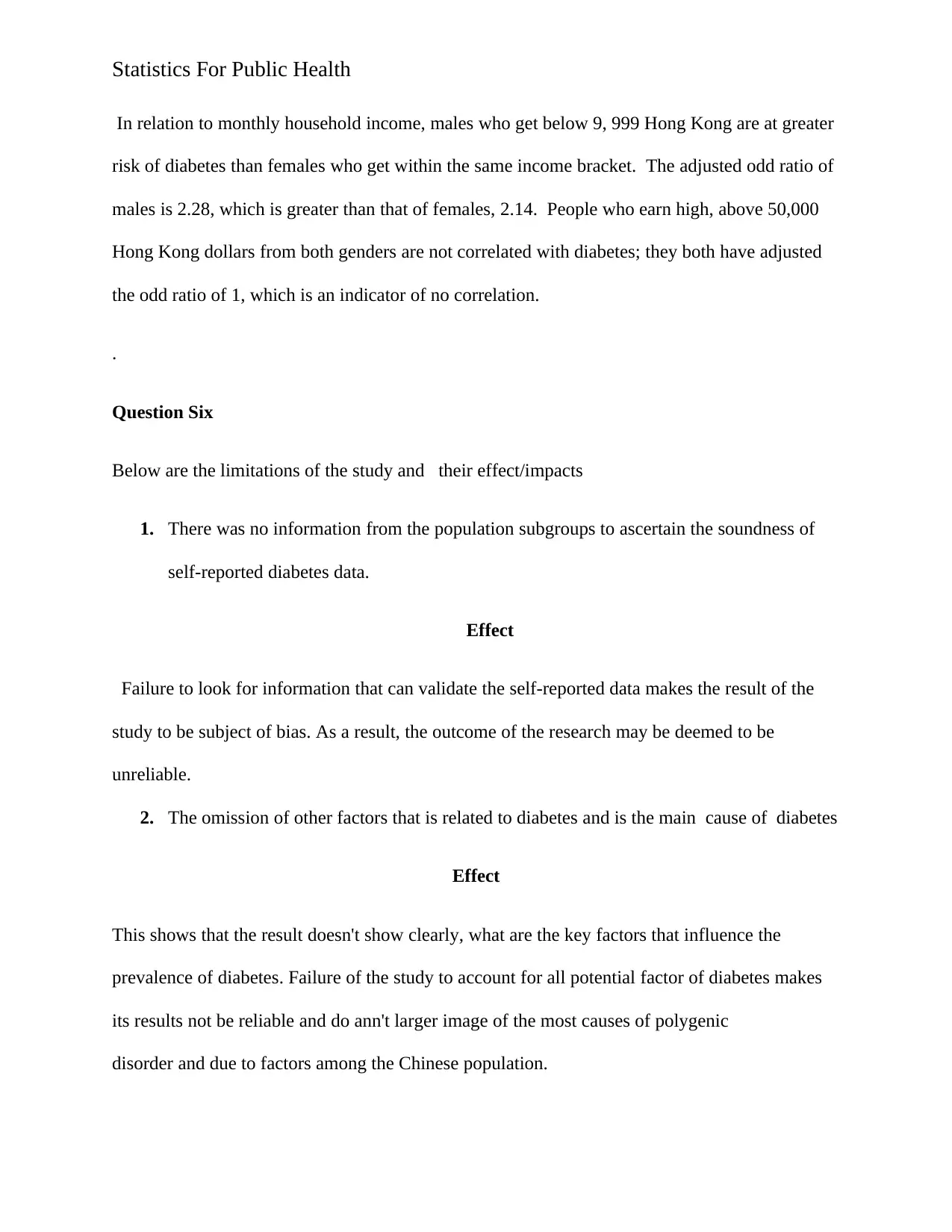
Statistics For Public Health
In relation to monthly household income, males who get below 9, 999 Hong Kong are at greater
risk of diabetes than females who get within the same income bracket. The adjusted odd ratio of
males is 2.28, which is greater than that of females, 2.14. People who earn high, above 50,000
Hong Kong dollars from both genders are not correlated with diabetes; they both have adjusted
the odd ratio of 1, which is an indicator of no correlation.
.
Question Six
Below are the limitations of the study and their effect/impacts
1. There was no information from the population subgroups to ascertain the soundness of
self-reported diabetes data.
Effect
Failure to look for information that can validate the self-reported data makes the result of the
study to be subject of bias. As a result, the outcome of the research may be deemed to be
unreliable.
2. The omission of other factors that is related to diabetes and is the main cause of diabetes
Effect
This shows that the result doesn't show clearly, what are the key factors that influence the
prevalence of diabetes. Failure of the study to account for all potential factor of diabetes makes
its results not be reliable and do ann't larger image of the most causes of polygenic
disorder and due to factors among the Chinese population.
In relation to monthly household income, males who get below 9, 999 Hong Kong are at greater
risk of diabetes than females who get within the same income bracket. The adjusted odd ratio of
males is 2.28, which is greater than that of females, 2.14. People who earn high, above 50,000
Hong Kong dollars from both genders are not correlated with diabetes; they both have adjusted
the odd ratio of 1, which is an indicator of no correlation.
.
Question Six
Below are the limitations of the study and their effect/impacts
1. There was no information from the population subgroups to ascertain the soundness of
self-reported diabetes data.
Effect
Failure to look for information that can validate the self-reported data makes the result of the
study to be subject of bias. As a result, the outcome of the research may be deemed to be
unreliable.
2. The omission of other factors that is related to diabetes and is the main cause of diabetes
Effect
This shows that the result doesn't show clearly, what are the key factors that influence the
prevalence of diabetes. Failure of the study to account for all potential factor of diabetes makes
its results not be reliable and do ann't larger image of the most causes of polygenic
disorder and due to factors among the Chinese population.
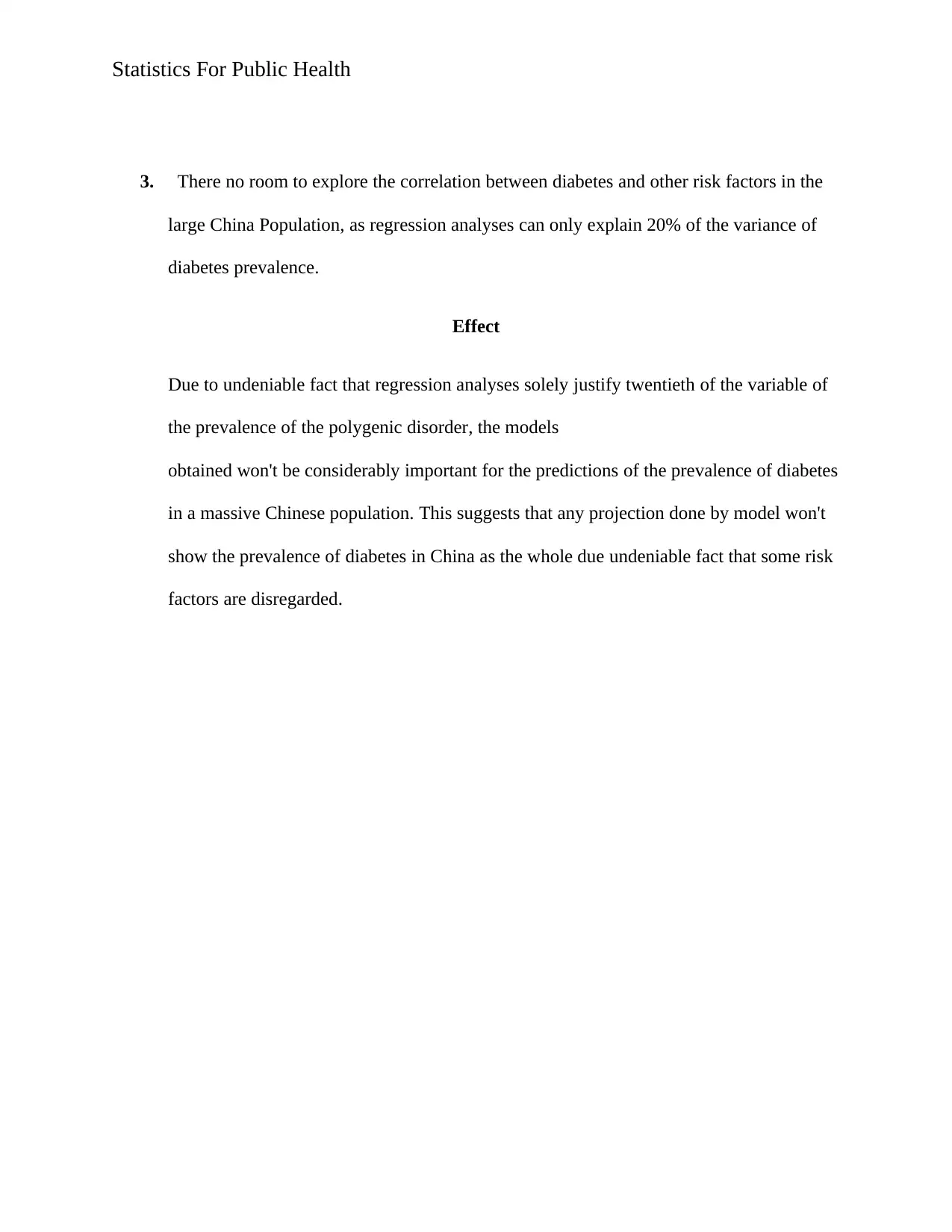
Statistics For Public Health
3. There no room to explore the correlation between diabetes and other risk factors in the
large China Population, as regression analyses can only explain 20% of the variance of
diabetes prevalence.
Effect
Due to undeniable fact that regression analyses solely justify twentieth of the variable of
the prevalence of the polygenic disorder, the models
obtained won't be considerably important for the predictions of the prevalence of diabetes
in a massive Chinese population. This suggests that any projection done by model won't
show the prevalence of diabetes in China as the whole due undeniable fact that some risk
factors are disregarded.
3. There no room to explore the correlation between diabetes and other risk factors in the
large China Population, as regression analyses can only explain 20% of the variance of
diabetes prevalence.
Effect
Due to undeniable fact that regression analyses solely justify twentieth of the variable of
the prevalence of the polygenic disorder, the models
obtained won't be considerably important for the predictions of the prevalence of diabetes
in a massive Chinese population. This suggests that any projection done by model won't
show the prevalence of diabetes in China as the whole due undeniable fact that some risk
factors are disregarded.
⊘ This is a preview!⊘
Do you want full access?
Subscribe today to unlock all pages.

Trusted by 1+ million students worldwide
1 out of 13
Related Documents
Your All-in-One AI-Powered Toolkit for Academic Success.
+13062052269
info@desklib.com
Available 24*7 on WhatsApp / Email
![[object Object]](/_next/static/media/star-bottom.7253800d.svg)
Unlock your academic potential
Copyright © 2020–2025 A2Z Services. All Rights Reserved. Developed and managed by ZUCOL.





